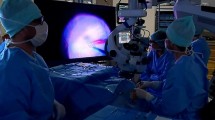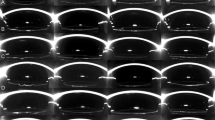Abstract
Objective
To report preliminary experience using the BeyeonicsOne (Beyeonics Vision, Haifa, Israel) digital visualization platform and the utilization of its three-dimensional (3D) head-mounted display (HMD) in cataract surgery.
Methods
An interventional case series including patients who underwent cataract surgery using the 3D HMD platform at the Tel Aviv Medical Center. The system uses the HMD unit to display high-resolution real-time 3D surgical field images. Collected data included patient demographics, ocular comorbidities, risk factors for complex cataract surgery, cataract grading, preoperative and postoperative best-corrected visual acuity (BCVA), and intra- and postoperative complications.
Results
In total, 60 eyes of 60 subjects (mean age 73.1 ± 8.4 years) were included. Mean preoperative BCVA was 0.40 ± 0.30 logMAR (Snellen equivalent ~20/50) and improved to 0.10 ± 0.10 logMAR (Snellen equivalent ~20/25, p < 0.001). None of the patients suffered BCVA loss. All procedures and follow-ups were uneventful except for one case of a posterior capsular tear and one case of post-surgical cystoid macular edema.
Conclusion
The visualization platform and its embedded 3D head-mounted display can be easily used in routine cataract surgery with the added benefits of improved ergonomics, high picture quality and enhanced image control.
This is a preview of subscription content, access via your institution
Access options
Subscribe to this journal
Receive 18 print issues and online access
$259.00 per year
only $14.39 per issue
Buy this article
- Purchase on Springer Link
- Instant access to full article PDF
Prices may be subject to local taxes which are calculated during checkout


Similar content being viewed by others
Data availability
All data generated or analyzed during this study are included in this published article.
References
Keeler R. The evolution of the ophthalmic surgical microscope. Hist Ophthalmol Int. 2015;1:35–66.
Eckardt C, Paulo EB. Heads-up surgery for vitreoretinal procedures: an experimental and clinical study. Retina. 2016;36:137–47.
Montes De Oca I, Kim EJ, Wang L, Weikert MP, Khandelwal SS, Al-Mohtaseb Z, et al. Accuracy of toric intraocular lens axis alignment using a 3-dimensional computer-guided visualization system. J Cataract Refract Surg. 2016;42:550–5.
Palácios RM, de Carvalho ACM, Maia M, Caiado RR, Camilo DAG, Farah ME. An experimental and clinical study on the initial experiences of Brazilian vitreoretinal surgeons with heads-up surgery. Graefes Arch Clin Exp Ophthalmol 2019;257:473–83.
Palácios RM, Kayat KV, Morel C, Conrath J, Matonti F, Morin B, et al. Clinical study on the initial experiences of French vitreoretinal surgeons with heads-up surgery. Curr Eye Res. 2020;45:1265–72.
Weinstock RJ, Ainslie-Garcia MH, Ferko NC, Qadeer RA, Morris LP, Cheng H, et al. Comparative assessment of ergonomic experience with heads-up display and conventional surgical microscope in the operating room. Clin Ophthalmol. 2021;15:347–56.
Helayel HB, Al-Mazidi S, Alakeely A. Can the three-dimensional heads-up display improve ergonomics, surgical performance, and ophthalmology training compared to conventional microscopy? Clin Ophthalmol. 2021;15:679.
Charles S. Illumination and phototoxicity issues in vitreoretinal surgery. Retina. 2008;28:1–4.
Nariai Y, Horiguchi M, Mizuguchi T, Sakurai R, Tanikawa A. Comparison of microscopic illumination between a three-dimensional heads-up system and eyepiece in cataract surgery. Eur J Ophthalmol. 2021;31:1817–21.
Adam MK, Thornton S, Regillo CD, Park C, Ho AC, Hsu J. Minimal endoillumination levels and display luminous emittance during three-dimensional heads-up vitreoretinal surgery. Retina. 2017;37:1746–9.
Panthier C, Courtin R, Moran S, Gatinel D. Heads-up descemet membrane endothelial keratoplasty surgery: feasibility, surgical duration, complication rates, and comparison with a conventional microscope. Cornea. 2021;40:415–9.
Gomel N, Levinger E, Lankry P, Cohen S, Schwartz S, Barak A, et al. Use of a novel three-dimensional head-mounted digital visualization platform in corneal endothelial transplantation. Ophthalmol Ther. 2023;12:625–31.
Author information
Authors and Affiliations
Contributions
NS was responsible for designing the work, acquiring and analyzing data, drafting the manuscript and revising the manuscript. EL was responsible for designing the work, acquiring data, and revising the manuscript. AA was responsible for acquiring data, analyzing data, and revising the manuscript. NG was responsible for acquiring data and revising the manuscript. SC was responsible for acquiring data and revising the manuscript. GR was responsible for interpreting data and revising the manuscript. SS was responsible for acquiring data and revising the manuscript. AB was responsible for designing the work, acquiring data, and revising the manuscript. AL was responsible for designing the work, interpreting data, and revising the manuscript. DV was responsible for designing the work, interpreting data, and revising the manuscript.
Corresponding author
Ethics declarations
Competing interests
AB, NS and AL are consultants for Beyeonics Vision. NS received advisory board honoraria from Beyeonics Vision.
Additional information
Publisher’s note Springer Nature remains neutral with regard to jurisdictional claims in published maps and institutional affiliations.
Supplementary information
Rights and permissions
Springer Nature or its licensor (e.g. a society or other partner) holds exclusive rights to this article under a publishing agreement with the author(s) or other rightsholder(s); author self-archiving of the accepted manuscript version of this article is solely governed by the terms of such publishing agreement and applicable law.
About this article
Cite this article
Sorkin, N., Levinger, E., Achiron, A. et al. Use of a three-dimensional head-mounted digital visualization platform in cataract surgery. Eye 37, 2905–2908 (2023). https://doi.org/10.1038/s41433-023-02427-w
Received:
Revised:
Accepted:
Published:
Issue Date:
DOI: https://doi.org/10.1038/s41433-023-02427-w



